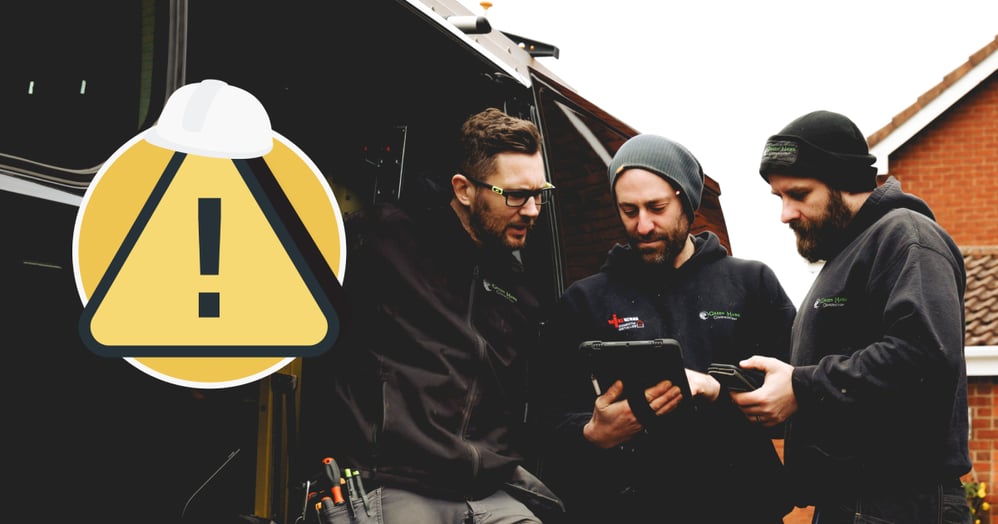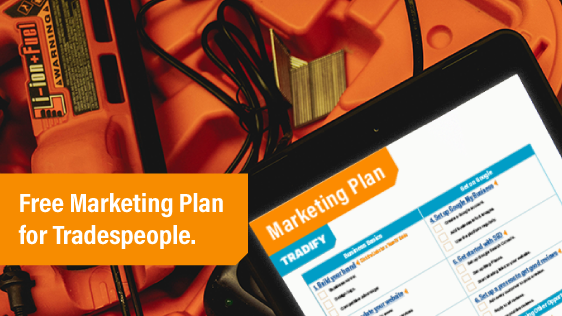Tips for Running Toolbox Meetings + Free Template
by Team Tradify, February 15, 2022

Table of Contents
As a business owner, you should give your team ample opportunities to raise Health & Safety (H&S) questions and take an active role in ensuring everyone on site remains safe. One way trade businesses tackle this is through toolbox meetings (also called toolbox talks).
A toolbox meeting is an informal daily or weekly chat, usually done onsite, about the jobs to be done that week. Your team can raise any concerns they have, as well as discuss incidents that have happened since the last talk.
Short on time? Skip ahead:
- 1. The importance of health & safety
- 2. What is a toolbox meeting/toolbox talk?
- 3. Tips for successful toolbox meetings
- 4. When should you have a toolbox meeting?
- 5. Benefits of toolbox meetings
1. The importance of health & safety
Proactive team discussion around health & safety is the most effective way to reduce risk. To make things easier for you, we've put together a free toolbox talk template that you can use to make sure you're running your toolbox meetings successfully.
Running effective toolbox meetings helps you to fulfil your duties under Health & Safety legislation. In many cases, a regular toolbox talk can help reduce your compliance workload by helping you to focus on priorities relevant to your current work.
- Health & Safety Requirements for UK Trade Businesses
- Health & Safety Requirements for US Trade Businesses
- Health & Safety Requirements for Australian Trade Businesses
- Health & Safety Requirements for New Zealand Trade Businesses
2. What is a toolbox meeting/toolbox talk?
There are varied ideas around what a toolbox meeting is, what should be incorporated in it and why it needs to be done.
Most health and safety legislation around the world requires two-way communication and agreement duties around health & safety matters. The law aside, good communication and cooperation between workers and contractors operating on the same worksite is key to good productivity. If done well, toolbox meetings can help ensure everyone goes home safe at the end of the day.
It is very important that when one worker’s activities on site adversely impact another, these activities are coordinated between workers. A good forum to do this is through toolbox meetings. Another great way to hear out your employees and learn if they have any health & safety concerns that you're not aware of is by conducting a quick health & safety survey.
Use this survey to find out how effective your current H&S processes are — or if there are gaps that need filling.
3. Tips for successful toolbox meetings
A toolbox meeting should not just be a bunch of workers or contractors discussing a particular risk. While this is useful, a toolbox meeting gives you an opportunity to discuss various H&S related subjects in one meeting.
Below are some tips to guide the discussion around key subjects. While not all the points will be relevant every day or at every site, it’s an excellent prompt for initiating discussion.
Toolbox Meeting subjects can include:
- Recent findings from a site review and what actions are needed to improve risks that aren’t being adequately controlled.
- Risks associated with a current or upcoming task, and what controls you need to put in place to manage these.
- Findings from any recent events (injury/illness/incident/near miss) that need to be discussed to prevent the event from occurring again.
- Emergency planning for the workplace.
- Worker and job induction procedures.
- Expected training, competency and supervision standards for the workplace.
- Specific worksite rules – such as no 3-step ladders or dry sweeping.
- The minimum required PPE and when it’s to be used.
- Management of hazardous substances.
- Worksite facilities for health and safety.
And the most important aspect of any toolbox meeting:
- Feedback from contractors and workers around health and safety.
4. When should you have your toolbox meeting?
Ideally, a toolbox meeting should be conducted weekly, as work and the associated risks change regularly. Contractors come and go from a site, so there is always something new that might influence others.
First thing on a Monday morning is an ideal time for a toolbox talk – to reflect on what happened last week and discuss what's coming up for the week ahead. It's good to get everybody on the same page at the start of the week.
5. Benefits of toolbox meetings
Toolbox meetings are an effective leadership tool that affords a worksite manager the opportunity to guide the worksite and demonstrate their commitment and the company’s dedication to running a safe worksite, promoting teamwork and driving the message of 'safety first'.
They’re also a great opportunity for workers to voice their concerns or support, and this should be actively encouraged. If you’re serious about managing safety in the workplace, then toolbox talks should be a vital part of your process. If done well, they reinforce safety messages and drive behaviour that supports a culture of safety before anything else.
If you want to know more ways to cut out the admin and systemise your business, see what Tradify can do for you by signing up for a free 14-day trial or catching one of our live weekly walkthroughs.
Related articles

Seamless Scheduling for Scoreboard Enterprises

The Best HVAC Safety Equipment

The Best PPE for HVAC Technicians
Give Tradify a go for free!
Save 10+ hours/week on business admin with the highest-rated job management software for tradespeople.
With free one-on-one training and phone support, it's never been easier to get started.




